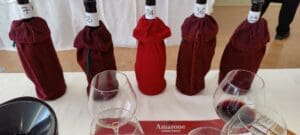I am sorry amici. But whenever I think Italian, the first thing that comes to mind, is Mafia. That’s before pizza, wines, truffles and olive oil. No offence but that’s how Hollywood portrayed you guys. Blame it on Francis Ford Coppola. Istituto del vino italiano di qualità Grandi Marchi, or the Italian Wine Institute of Premium Brands represents nineteen family owned Italian brands. Families and fraternity. You get the drift, don’t you?
Combining more than 3,000 years of experience, the group is a blend of diverse stories and contrasting characters. Formed in 2004, today the 19 wineries institute led by Marchese Piero Antinori presents wine styles from twelve regions of Italy. At home, the institute aims to drive advancement of wine making parallel with efforts to preserve their traditions. And aboard, it promotes wines through educational seminars.
Forming alliance among families isn’t an Italian thing. The Primum Familiae Vini or First Families of Wine is an alliance forged among some of the biggest across western Europe. In the southern hemisphere, New Zealand has The Family of Twelve and Australia has its First Families of Wine. One shared condition, and that is the winery must be family owned.
There’s strength in numbers. Collaboration exists in various forms in the wine industry. The Burgundian négociant and KWV of South Africa are a form of alliance with vine growers sharing profits through sales of wine under a common label. The families alliances, however, choose to preserve these identities. Instead of profit, they split the cost.
Ultimately the most crucial condition for success of a collaboration is the existence of homogeneous interest. In the case of négociant and KWV, their purpose is to make, bottle and market wines exclusively for their members and distribute their deserved keep. In the premium side of Italian families alliance, the depth of homogeneity can become significantly shallow. Coordination of members’ meeting is already a hassle to begin with, and much less can be achieved if there’s a call for synchronised business action.
But for me, all that matters is the continuity of great wine making. But seeing most are well covered in our market, I think these Italian regions deserve more attention than the rest. So, Tuscany you have my apologies.
Tasca d’Almerita, Rosso del Conte 2008, Contea di Sclafani DOC
My impression of Sicilian red wines had been typical strong alcohol power, herbal Nero d’Avola and altogether, linear.
Rosso del Conte, the finest wine from Tasca d’Almerita was an eye-opener. Meeting the minimal legal requirements of 50 per cent Nero d’Avola and Perricone (either together or separately), the inclusion of Syrah (25 per cent) and Merlot (23 per cent) yield a product so intriguing and complex. Showing fresh black cherries, licorice, vanilla and spices. The palate was a soft elegance I have never observed from Sicily, richness carried by light silky touch and fresh lifting acidity.
I am a reserved man, but this wine prompted me to openly declared as “Fantastic!” amidst the solemn atmosphere of master class.
Donnafugata, Ben Ryè 2011, Passito di Pantelleria DOP
The name Donnafugata was mentioned on Twitter several times but I have not realised how big a name it is. Like the Tasca d’Almerita, Donnafugata hails from Sicily and considered by many as the Prima Donna.
The Passito di Pantelleria law permits the co-fermentation of both fresh Muscat juice with addition from sun-dried Muscat grapes. As such, this Muscat wine from Donnafugata was intensely rich compared to the Moscato of the north. Ripe pineapple, seemingly copious amount of honey, small touch of raisin and apricots. Carefully balanced with crisp acidity despite residual sugar level measured at 200 grammes per litre. The lingering finish was simply delightful, with the overall experience comparable to a young Sauternes.
Masi Agricola, Riserva di Costasera 2007, Amarone Classico Riserva DOC
For a while, I had admiration for the wines of Amarone. But eventually too much of a good thing proves to be, too much. I was simply overwhelmed by their sheer power. Seeing a bottle of Riserva di Costasera with 15.5 per cent alcohol and I was certain there was no pleasure for me in the glass.
The initial whiff of fresh berry jam have me hooked instead of pushing away from the powerful nasal uppercut. Juicy mouth-fill served on a solid velvety structure. Excellent balance and long finish. And right before I got carried away with the sense of vivo la dolce vita, a gentle nudge of bitterness reminded me that this was an Amarone after all.
Note: In 2010, the Amarone della Valpolicella DOCG was ratified after being a DOC for 42 years.



